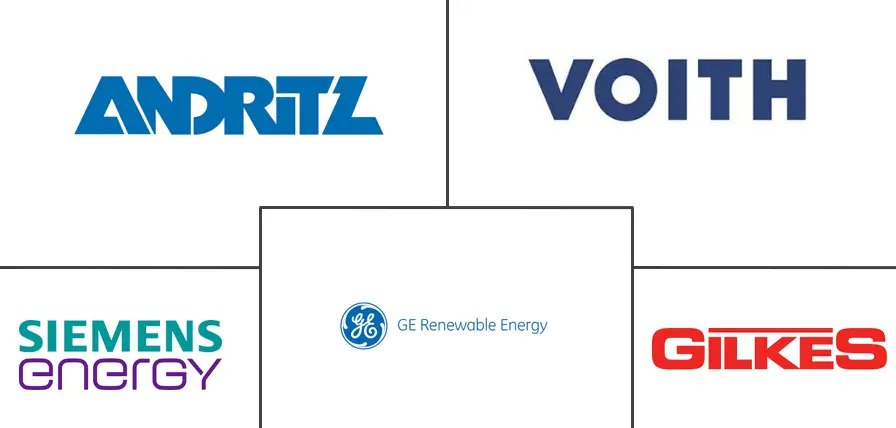Market Size of Small Hydropower Industry

| Study Period | 2019 - 2029 |
| Base Year For Estimation | 2023 |
| CAGR (2024 - 2029) | 3.48 % |
| Fastest Growing Market | Asia-Pacific |
| Largest Market | Asia-Pacific |
| Market Concentration | Low |
Major Players
*Disclaimer: Major Players sorted in no particular order |
Small Hydropower Market Analysis
The Small Hydropower Market size in terms of installed base is expected to grow from 90.39 gigawatt in 2024 to 107.12 gigawatt by 2029, at a CAGR of 3.48% during the forecast period (2024-2029).
- Over the medium term, factors like increasing investment in the small hydropower market and increasing demand for clean electricity are expected to drive the market.
- On the other hand, an unstable energy supply significantly hinders market growth.
- Nevertheless, integrating IoT with hydropower and the positive outlook toward small hydropower dams to sustain lives in rural communities are expected to create enormous opportunities for the Small Hydropower Market.
- Asia-Pacific is expected to be the largest market in the forecast period due to the high demand for electricity in the region. This will facilitate further growth.
Small Hydropower Industry Segmentation
Small hydropower refers to hydroelectric power plants with an installed capacity of less than 10MW. These plants generate electrical energy by harnessing the gravitational force of falling or flowing water to drive turbines and generators. Water, primarily through the natural processes of evaporation, wind, and rain, returns to its original height, underscoring its renewable nature. Small-scale hydropower can effectively electrify isolated sites and bolster national electricity production during peak demand.
The small hydropower market is segmented by capacity, application, and geography. By capacity, the market is segmented into up to 1 MW and 1-10 MW. By application, the market is segmented into power infrastructure, civil works, and other applications. The report also covers the market size and forecasts for the small hydropower market across major regions. For each segment, the market sizing and forecasts have been done based on installed capacity.
| Capacity | |
| Up to 1 MW | |
| 1-10 MW |
| Application | |
| Power Infrastructure | |
| Civil Works | |
| Other Applications |
| Geography | |||||||||||
| |||||||||||
| |||||||||||
| |||||||||||
| |||||||||||
|
Small Hydropower Market Size Summary
The small hydropower market is poised for steady growth, driven by increasing investments and a rising demand for electricity. Despite the initial setbacks due to the COVID-19 pandemic, the market has rebounded to pre-pandemic levels. The integration of IoT technologies and the positive impact of small hydropower dams on rural communities are expected to create significant opportunities. However, challenges such as unstable energy supply continue to pose hurdles. The Asia-Pacific region is anticipated to lead the market, fueled by high electricity demand and rapid technological advancements. The 1-10 MW segment is projected to dominate, particularly in developing countries like India and China, where small-scale decentralized projects are being deployed for rural electrification.
The Asia-Pacific region has established itself as a dominant force in the small hydropower market, with countries like India and China prioritizing these projects alongside other renewable energy sources. Vietnam's Power Development Plan 8 further underscores the region's commitment to expanding its renewable energy capacity, including small hydropower. The global market remains fragmented, with key players such as Andritz AG, Voith GmbH & Co. KGaA, and Siemens Energy AG actively participating. Recent developments, such as the funding for the Dupinga Mini Hydropower project in the Philippines, highlight ongoing efforts to enhance renewable energy infrastructure. Overall, the small hydropower market is expected to continue its growth trajectory, with Asia-Pacific maintaining its leadership position.
Small Hydropower Market Size - Table of Contents
-
1. MARKET OVERVIEW
-
1.1 Introduction
-
1.2 Installed Capacity and Forecast, till 2029
-
1.3 Small Hydropower Installed Capacity Share, by Major Region, 2023
-
1.4 Small Hydropower Projects in Pipeline and Upcoming
-
1.5 Recent Trends and Developments
-
1.6 Government Policies and Regulations
-
1.7 Market Dynamics
-
1.7.1 Drivers
-
1.7.1.1 Surge in Demand for Clean and Sustainable Power
-
-
1.7.2 Restraints
-
1.7.2.1 Unstable Energy Supply
-
-
-
1.8 Supply Chain Analysis
-
1.9 Porter's Five Forces Analysis
-
1.9.1 Bargaining Power of Suppliers
-
1.9.2 Bargaining Power of Consumers
-
1.9.3 Threat of New Entrants
-
1.9.4 Threat of Substitute Products and Services
-
1.9.5 Intensity of Competitive Rivalry
-
-
-
2. MARKET SEGMENTATION
-
2.1 Capacity
-
2.1.1 Up to 1 MW
-
2.1.2 1-10 MW
-
-
2.2 Application
-
2.2.1 Power Infrastructure
-
2.2.2 Civil Works
-
2.2.3 Other Applications
-
-
2.3 Geography
-
2.3.1 North America
-
2.3.1.1 United States
-
2.3.1.2 Canada
-
2.3.1.3 Rest of North America
-
-
2.3.2 Europe
-
2.3.2.1 Germany
-
2.3.2.2 United Kingdom
-
2.3.2.3 France
-
2.3.2.4 Italy
-
2.3.2.5 Spain
-
2.3.2.6 Nordic
-
2.3.2.7 Turkey
-
2.3.2.8 Russia
-
2.3.2.9 Rest of Europe
-
-
2.3.3 Asia-Pacific
-
2.3.3.1 China
-
2.3.3.2 India
-
2.3.3.3 Japan
-
2.3.3.4 South Korea
-
2.3.3.5 Malaysia
-
2.3.3.6 Thailand
-
2.3.3.7 Vietnam
-
2.3.3.8 Rest of Asia-Pacific
-
-
2.3.4 Middle East and Africa
-
2.3.4.1 Saudi Arabia
-
2.3.4.2 United Arab Emirates
-
2.3.4.3 Nigeria
-
2.3.4.4 Egypt
-
2.3.4.5 South Africa
-
2.3.4.6 Rest of Middle East and Africa
-
-
2.3.5 South America
-
2.3.5.1 Brazil
-
2.3.5.2 Argentina
-
2.3.5.3 Colombia
-
2.3.5.4 Rest of South America
-
-
-
Small Hydropower Market Size FAQs
How big is the Small Hydropower Market?
The Small Hydropower Market size is expected to reach 90.39 gigawatt in 2024 and grow at a CAGR of 3.48% to reach 107.12 gigawatt by 2029.
What is the current Small Hydropower Market size?
In 2024, the Small Hydropower Market size is expected to reach 90.39 gigawatt.

